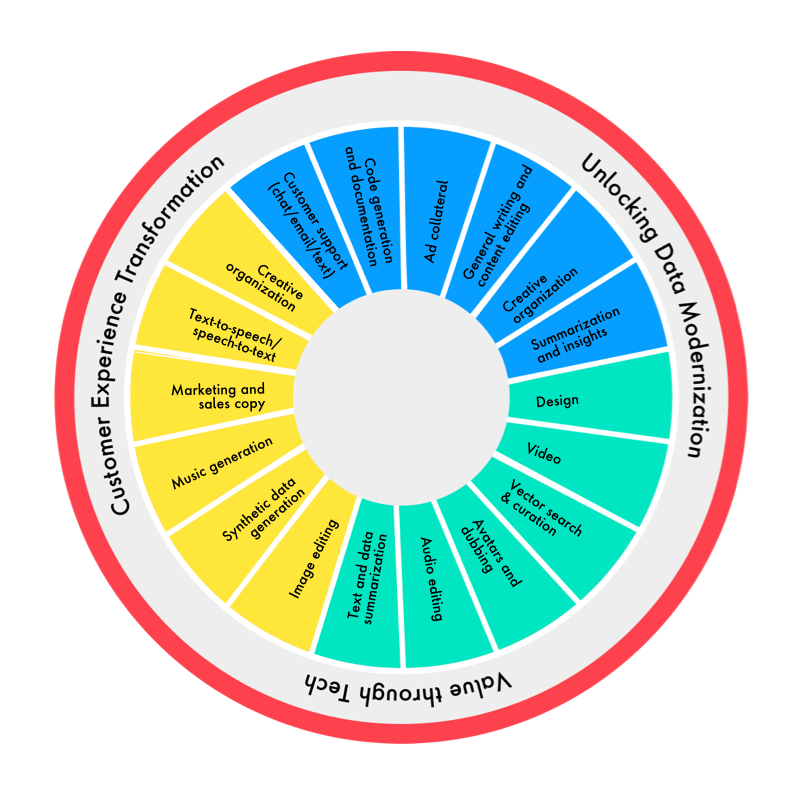What issue can we solve for you?
Type in your prompt above or try one of these suggestions
Suggested Prompt


In January 2023, generative AI chatbot ChatGPT reached an estimated 100 million monthly active users—just two months after launch—making it the fastest-growing consumer application in history. Yes, that’s including TikTok, Instagram, Twitter and Facebook. So, what’s the big idea—is this all just hype, or will this be a game-changing play to stay competitive in the space? How can generative AI impact business as we know it?
This new wave of generative AI technologies has the potential to change entire industries at the click of a button. To remain a market leader and stay competitive in the space, organizations will need a clear and compelling generative AI strategy. Businesses can use generative AI to enhance workflows rather than replace human roles—with a more human-AI collaboration in mind. With the technology rapidly evolving, it’s critical to understand the business imperative behind generative AI and how organizations can best meet the moment.
Make the most of your relationship with AI: Generative AI business value
Generative AI isn’t just about bringing automation to the forefront; it’s about creating a reciprocal relationship where organizations can reimagine how humans get work done with generative AI at their fingertips. Humans give generative AI context and generative AI can then deploy.
With proper strategy and execution in place, generative AI can begin to unlock business use cases for organizations to scale. Here are some of the business use cases for generative AI.
AI for business: Use cases for generative AI

Pros and cons of using generative AI for business delivery
While it’s critical to embrace the progress of generative AI and how it will impact delivery, it’s also important to remain aware of some of the risks. Let’s take a closer look at the benefits and risks of generative AI.
Benefits of using generative AI:
-

Flexibility
Provide a wide array of content at scale with rapid iteration (such as text, images, audio, etc.) and generative AI can also learn and adapt to new situations

Efficiency
Help automate website development and coding in languages like JavaScript—additionally, it can also help debug code

Personalization
Analyze a user’s purchasing history and online behavior to offer product recommendations
-

Digital innovation
A virtual assistant that can process, analyze and use the information given (and make these actions and processes repeatable)

Data generation
Overcome data scarcity issues by generating new, original content using data in ways that were previously unimagined or impossible

Cost optimization
By streamlining processes, organizations can reduce operational costs
Risks of using generative AI:
-

Lots of data needed to train:
Generative AI needs to be trained on large amounts of data to work effectively.

Ethical and legal considerations:
Organizations will need a strategic and managed approach to create an ethical framework for success to guard against bad actors.
e.g., Getty Images pending lawsuit against Stability AI (Stable Diffusion)
False flags or misinformation:
Sometimes, there are unintended consequences of using generative AI, like promoting false information or encouraging addictive behaviors.
e.g., In 2018, Amazon used LLMs to screen candidates for job interviews, which discriminated against women and minorities. Businesses should use a diverse data and validation guard rails set to overcome any potential confirmation bias within systems.
Simon James, International Lead Data & AI, says organizations should be aware that generative AI will need to prioritize human oversight to avoid the risk that businesses may become too comfortable leaving generative AI to make a majority of decisions.
Generative AI is a rapidly growing technology with various potential use cases and applications. As this technology continues to evolve, expect to see these risks and limitations addressed with growing AI capabilities and access to real-time data.
The future is generative AI—make the next move
Generative AI will drive future impact, distinguish how businesses compete and revolutionize the ways people do business with a focus on strategy, product, engineering, experience and data. Organizations that want to seize the moment will need to evolve with generative AI to keep pace with competitors and continue to produce measurable value.
With the potential to better simplify, personalize, and democratize access to new and existing applications, generative AI is for every business—the race, is on.








